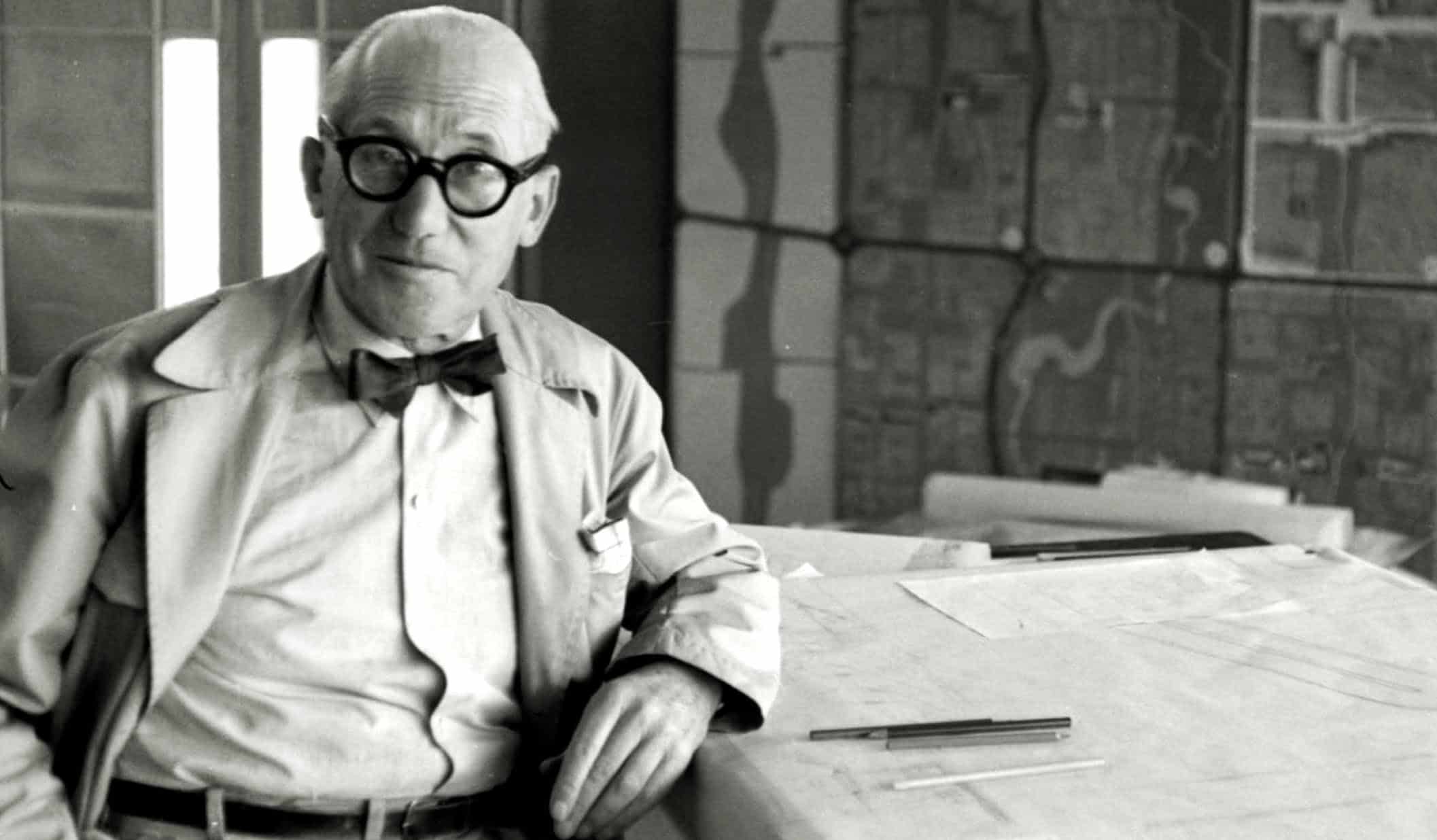Creators
Corbusier Manifesto: Five Points of New Architecture
Charles-Édouard Jeanneret, better known as architect Le Corbusier had radical ideas when it came to architectural design. The clean minimalist design esthetic was born at the Bauhaus but perfected by Corbu’s extensive use of white concrete.
Perhaps the most influential architect of the 20th century, Le Corbusier not only shaped modern architecture but helped to define modernity and the International Style. His early writings and buildings glorified modernism and praised modernity as the key to recovery from World War I. Corbu’s faith in technology and heavy industry helped create what many would later call “the machine age”.
Written in 1927, Le Corbusier’s Cinq Points de l’Architecture Moderne or The Five Points of a New Architecture may have been the basis of the architectural design concept behind one of his most famous works, Villa Savoy (1929-1931). These five points would dictate his architectural design style for the rest of his career and the careers of many other architects.
The new modular design system allowed for an “infinite number of combinations of plans”. This functional vision for residential design was as he called it “a machine for living in”. The influence of these design points reach beyond Corbusier buildings and can be seen in the works of other architects Mies van der Rohe, Philp Johnson, and many current architectural designs still today.
'The Five Points of a New Architecture' (1927)
- Pilotis. Replacement of ground floor supporting walls by a grid of reinforced concrete columns that bear the structural load is the basis of the new aesthetic.
- The free design of the ground plan. Raised on free-standing columns with the absence of supporting walls, means the ground floor is unrestrained in its internal use.
- The free design of the façade. Sparating the exterior of the building from its structural function sets the façade free from conventional structural constraints.
- Horizontal windows. The absence of load-bearing walls allows for windows of any size. Large horizontal windows increase the sense of space and lights rooms equally.
- Roof garden. A flat roof can serve a domestic purpose while providing essential protection to the concrete roof.
These five points were first published in L’Esprit Nouveau, a magazine he founded with poet Paul Dermée, and painter Amédée Ozenfant in 1920. As part of the popular modernist movement at the time, the publication addressed a wide range of artistic disciplines. The five points can also be found in Le Corbusier’s most famous book Towards a New Architecture, which is considered by some to be the most important architectural work published in the 20th century. Vers Une Architecture was first published in 1923 and translated in 1927 quickly became required reading for any architectural student. Through essays and illustrations, Corbusier breaks down the classical perfection of the Parthenon and adapts these design principles to the machine age. He praises order as the root of modernism and coins the phrase “A house is a machine for living in.”
The Machine for Living
Corbusier believed that buildings should be designed as machines for living, with every element serving a specific function. He rejects the ornate styles of the past and instead calls for an architecture that is simple, efficient, and expressive of its purpose. He believes that the primary function of a building is to provide shelter and that every other function, such as aesthetics, should be secondary.
Another key point of the book is the concept of the “vertical garden city.” Corbusier proposed the idea of building tall, densely-populated cities that would be surrounded by green spaces. He believed that the vertical garden city would provide a solution to the overcrowding and pollution of the industrial city, and he saw it as a way to create a more sustainable and livable urban environment.
Corbusier also discusses the importance of standardization and the use of modern materials like concrete and steel in architecture. He believes that standardization would make construction more efficient and less expensive, and that modern materials would allow for the construction of taller, more efficient buildings. He also believes that this would allow for the creation of new forms of architecture that would be expressive of the technological advancements of the time.
The book lays out a new vision for architecture that focuses on functionality, efficiency, and the use of modern materials and construction techniques. Corbusier’s ideas of the “machine for living” and the “vertical garden city” were particularly influential at the time. Clearly, they continue to shape the way architects think about the design of buildings and cities.
Villa Savoye Modernist Icon
Perhaps the greatest example of Corbu’s style is the Villa Savoye. Completed in 1931, it represents the key principles of modernism including the use of innovative materials, functional design, open spaces, and a rejection of excessive ornamentation. The building was designed to serve the functional needs of its occupants efficiently. Its open spaces and flexible layout were intended to adapt to the changing needs of the family living there.
Villa Savoye is often studied in architectural education as a case study in modernist design principles. It serves as a source of inspiration and a reference point for architects and students interested in modern architecture and design. The Villa Savoye has become a cultural landmark and a destination for architecture enthusiasts and tourists. It has been recognized as a UNESCO World Heritage site since 2016, further highlighting its global significance.
Top 10 Modernist Le Corbusier Buildings
- Villa Savoye (Villa Savoye à Poissy)
Located in Poissy, France, Villa Savoye is perhaps the most renowned work by Le Corbusier. It is considered a masterpiece of modernist architecture and is celebrated for its innovative design, including the use of pilotis, an open floor plan, and a rooftop garden. - Unité d’Habitation
Le Corbusier designed several Unité d’Habitation buildings, with the most famous one being the Cité Radieuse in Marseille, France. These buildings are examples of his “housing unit” concept and feature a modular and efficient design for residential living. - Chandigarh Capitol Complex
Located in Chandigarh, India, this complex includes several government buildings, most notably the Secretariat Building and the Assembly Building. It is known for its large-scale and monumental modernist design. - Carpenter Center for the Visual Arts
Situated in Cambridge, Massachusetts, USA, the Carpenter Center is Le Corbusier’s only building in North America. It is part of Harvard University and is recognized for its striking sculptural form. - Ronchamp Chapel (Notre-Dame du Haut)
Located in Ronchamp, France, this chapel is celebrated for its unconventional and sculptural design. It is known for its curved walls, innovative use of light, and the sense of spirituality it conveys. - Villa La Roche and Villa Jeanneret (Maison La Roche et Maison Jeanneret)
These adjacent Corbusier buildings in Paris were designed by Le Corbusier and his cousin Pierre Jeanneret. They are early examples of modernist architecture and are recognized for their spatial innovation. - Palace of Assembly (Chandigarh)
Part of the Chandigarh Capitol Complex, this building serves as the legislative assembly for the Indian state of Punjab. It features a distinctive concrete brise-soleil (sun-breaker) and showcases Le Corbusier’s design principles. - High Court of Chandigarh
Another component of the Chandigarh Capitol Complex, the High Court building is noted for its rationalist design, including the use of raw concrete and a minimalist aesthetic. - Villa Stein (Villa Stein-de Monzie)
Situated in Garches, France, this villa is known for its elegant and streamlined design, with a focus on integrating indoor and outdoor spaces. - Maison Guiette
Situated in Antwerp, Belgium, Maison Guiette is a residence and studio designed by Le Corbusier for the painter René Guiette. It is notable for its incorporation of both living and working spaces within a modernist context.


